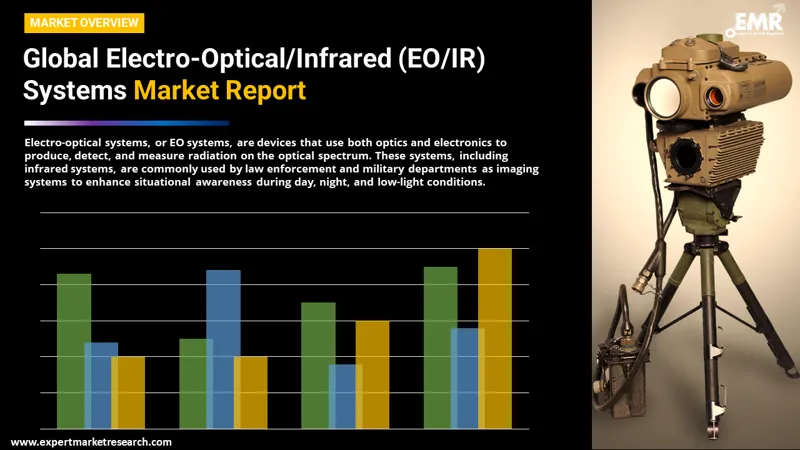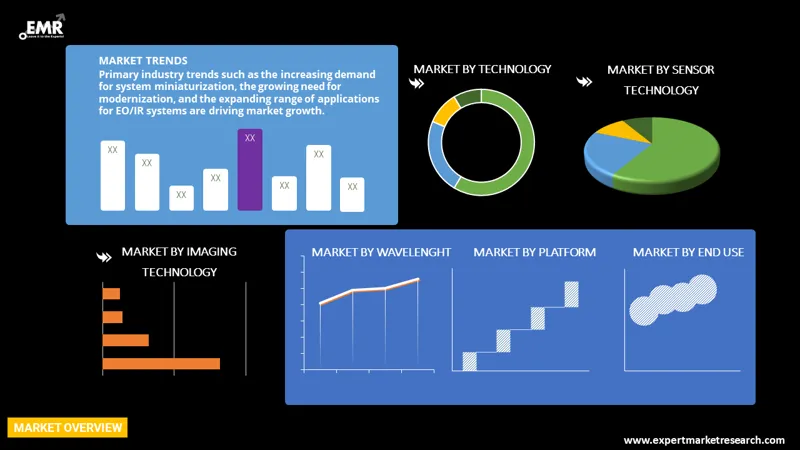
Consumer Insights
Uncover trends and behaviors shaping consumer choices today
Procurement Insights
Optimize your sourcing strategy with key market data
Industry Stats
Stay ahead with the latest trends and market analysis.
The global electro-optical/infrared (EO/IR) systems market attained a value of USD 15.63 Billion in 2025. The market is projected to grow at a CAGR of 3.70% between 2026 and 2035 to reach USD 22.48 Billion by 2035.
Base Year
Historical Period
Forecast Period
Compound Annual Growth Rate
3.7%
Value in USD Billion
2026-2035
*this image is indicative*
Devices that use a combination of optics and electronics for producing, detecting, and measuring radiation on the optical spectrum are referred to as electro-optical systems, or EO systems. Law enforcement and military departments generally use electro optical systems or infrared systems as imaging systems to improve situational awareness of settings during the day, at night, and even in low light situations. Common applications of EO/IR systems include airborne homeland security, surveillance, patrol, warfare, search and rescue, and reconnaissance missions.

Read more about this report - REQUEST FREE SAMPLE COPY IN PDF
The EMR’s report titled “Electro-Optical/Infrared (EO/IR) Systems Market Report and Forecast 2026-2035” offers a detailed analysis of the market based on the following segments:
Market Breakup by Technology
Market Breakup by Sensor Technology
Market Breakup by Imaging Technology
Market Breakup by Wavelength
Market Breakup by Platform
Market Breakup by End Use
Market Breakup by Region

Read more about this report - REQUEST FREE SAMPLE COPY IN PDF
The electro-optical/infrared (EO/IR) systems market by end use is anticipated to be dominated by the military sector throughout the forecasted period. Developments in sensor technology, increasing international tension and conflict, rising demand, and the preference for small unmanned aerial vehicles are some of the key drivers propelling the segment's expansion.
The development of complex and powerful sensor technologies, such as laser range finders, laser spot detectors, compass thermographic sensors, and low-light television cameras, is the result of technological developments. These modern tools have made a significant contribution in boosting terrestrial security.
Additionally, there have been more frequent instances of international conflict and territorial disputes. This has increased demand for advanced and high precision sensors. Small, unmanned aircrafts offer advantages such as easy navigation and undetected flying due to which they have been growing in popularity, increasing the demand for EO/IR systems.
North America is a leading shareholder in the global electro-optical/infrared (EO/IR) systems market and is anticipated to develop at the quickest rate during the forecast period. This is due to the strong demand for EO/IR systems from the United States armed forces. The United States has made significant investments in the research and acquisition of electro optical systems for various military platforms, including naval vessels, armoured vehicles, aircraft, submarines, unmanned aerial vehicles (UAV), and helicopters.
The United States is also increasing its expenditure in cutting-edge weapon systems due to the growing capabilities of other nations on the battlefield. Additionally, the increased purchase of advanced ISR and other equipment that improve the military's situational awareness was substantially influenced by the United States military's expanding involvement in numerous international conflicts.
The Asia Pacific region is anticipated to register substantial growth in the electro-optical/infrared (EO/IR) systems market. This can be attributed to the growing economies of countries in the region, which have fuelled expenditures in the military industry to fortify their current infrastructure. Growing territorial conflicts in the area and rising military spending are driving the market's expansion. As a result, the armed services in the region are investing heavily on plans to modernise their military electronics systems.
Additionally, it is anticipated that increased development and acquisition of cutting-edge military aircraft and unmanned vehicles for military operations in the Asia Pacific will increase the demand for effective systems like EO/IR systems, thus propelling the electro-optical/infrared (EO/IR) systems market growth.
The comprehensive EMR report provides an in-depth assessment of the market based on the Porter's five forces model along with giving a SWOT analysis. The report gives a detailed analysis of the following key players in the global electro-optical/infrared (EO/IR) systems market, covering their competitive landscape and latest developments like mergers, acquisitions, investments, and expansion plans.
Raytheon Technologies Corporation, a United States-based corporation, offers technology goods and services to the aerospace and defence sectors. The company's product line includes commercial, general aviation, and military aircraft engines, power generation management and distribution systems, engine control systems, and flight systems. Additionally, it provides solutions for hypersonic air warfare, command and control, cybersecurity, decision superiority, communications and navigation, naval warfare, land warfare, and space warfare.
Lockheed Martin Corporation, a global security and aerospace corporation, with its headquarters in Maryland in the United States, employs around 114,000 people worldwide. It focuses primarily on the manufacture, integration, and maintenance of high-tech systems, products, and services.
Thales Group, a leading provider of technology with its headquarters in Paris, France, has a reach across five continents. It is a supplier of cutting-edge technology, electronic systems, software, equipment, ground transportation, and services to the aerospace, defence, and security industries. For the land, marine, and air defence markets, the company also offers radio communications products, weapon systems, protection systems, vital information systems, network and infrastructure systems, and cybersecurity solutions.
*Please note that this is only a partial list; the complete list of key players is available in the full report. Additionally, the list of key players can be customized to better suit your needs.*
Other market players include Northrop Grumman Corporation, BAE Systems PLC, and Rheinmetall AG, among others.




*While we strive to always give you current and accurate information, the numbers depicted on the website are indicative and may differ from the actual numbers in the main report. At Expert Market Research, we aim to bring you the latest insights and trends in the market. Using our analyses and forecasts, stakeholders can understand the market dynamics, navigate challenges, and capitalize on opportunities to make data-driven strategic decisions.*
Get in touch with us for a customized solution tailored to your unique requirements and save upto 35%!
In 2025, the global market size for electro-optical/infrared (EO/IR) systems attained a value of nearly USD 15.63 Billion.
The market for electro-optical/infrared (EO/IR) systems is projected to grow at a CAGR of 3.70% between 2026 and 2035.
The market for electro-optical/infrared (EO/IR) systems is estimated to witness a healthy growth in the forecast period of 2026-2035 to reach a value of USD 22.48 Billion by 2035.
The major drivers of the electro-optical/infrared (EO/IR) systems market include rising military spending, increasing accuracy, and cost- and reliability-effectiveness, and investments in the research and acquisition of electro optical systems for various military platforms.
The expanding trend of system miniaturisation, increasing need for modernisation, and growing applications of EO/IR systems are the key market trends propelling the growth of the market.
The major players in the market are Raytheon Technologies Corporation, Lockheed Martin Corporation, Thales Group, Northrop Grumman Corporation, BAE Systems PLC, and Rheinmetall AG, L3Harris Technologies, Inc., among others.
Working wavelength or spectral quantum efficiency distinguishes the two: The electro-optic (EO) spectral band, often known as the near ultraviolet (UV) to near IR range of light, can be detected by a CCD, while IR detectors can detect the entire IR spectrum.
EO surveillance is a multi-sensor targeting and surveillance system that enables aircrews to find, track, and identify targets at a distance.
A sensor that uses electro-optics (EO) transforms light waves into electronic impulses. It takes a measurement of the actual amount of light and converts it into a form that a machine can read.
Optical sensors can detect light, typically in a particular area of the electromagnetic spectrum (ultraviolet, visible, and infrared). The sensor converts the wavelength, frequency, or polarisation of the detected light into an electric signal as a result of the photoelectric effect.
Explore our key highlights of the report and gain a concise overview of key findings, trends, and actionable insights that will empower your strategic decisions.
| REPORT FEATURES | DETAILS |
| Base Year | 2025 |
| Historical Period | 2019-2025 |
| Forecast Period | 2026-2035 |
| Scope of the Report |
Historical and Forecast Trends, Industry Drivers and Constraints, Historical and Forecast Market Analysis by Segment:
|
| Breakup by Technology |
|
| Breakup by Sensor Technology |
|
| Breakup by Imaging Technology |
|
| Breakup by Wavelength |
|
| Breakup by Platform |
|
| Breakup by End Use |
|
| Breakup by Region |
|
| Market Dynamics |
|
| Competitive Landscape |
|
| Companies Covered |
|
Datasheet
One User
USD 2,499
USD 2,249
tax inclusive*
Single User License
One User
USD 3,999
USD 3,599
tax inclusive*
Five User License
Five User
USD 4,999
USD 4,249
tax inclusive*
Corporate License
Unlimited Users
USD 5,999
USD 5,099
tax inclusive*
*Please note that the prices mentioned below are starting prices for each bundle type. Kindly contact our team for further details.*
Flash Bundle
Small Business Bundle
Growth Bundle
Enterprise Bundle
*Please note that the prices mentioned below are starting prices for each bundle type. Kindly contact our team for further details.*
Flash Bundle
Number of Reports: 3
20%
tax inclusive*
Small Business Bundle
Number of Reports: 5
25%
tax inclusive*
Growth Bundle
Number of Reports: 8
30%
tax inclusive*
Enterprise Bundle
Number of Reports: 10
35%
tax inclusive*
How To Order

Select License Type
Choose the right license for your needs and access rights.

Click on ‘Buy Now’
Add the report to your cart with one click and proceed to register.

Select Mode of Payment
Choose a payment option for a secure checkout. You will be redirected accordingly.
Gain insights to stay ahead and seize opportunities.

Get insights & trends for a competitive edge.

Track prices with detailed trend reports.

Analyse trade data for supply chain insights.

Leverage cost reports for smart savings

Enhance supply chain with partnerships.

Connect For More Information
Our expert team of analysts will offer full support and resolve any queries regarding the report, before and after the purchase.
Our expert team of analysts will offer full support and resolve any queries regarding the report, before and after the purchase.
We employ meticulous research methods, blending advanced analytics and expert insights to deliver accurate, actionable industry intelligence, staying ahead of competitors.
Our skilled analysts offer unparalleled competitive advantage with detailed insights on current and emerging markets, ensuring your strategic edge.
We offer an in-depth yet simplified presentation of industry insights and analysis to meet your specific requirements effectively.
Share